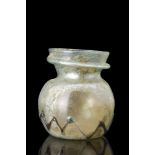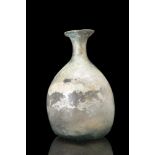Refine your search
Estimate
Category
- Jewellery (107)
- Sculpture (66)
- Coins (54)
- Arms, Armour & Militaria (50)
- Greek, Roman, Egyptian & Other Antiquities (50)
- Ceramics (32)
- Books & Periodicals (25)
- Collectables (22)
- Chinese Works of Art (20)
- Islamic Works of Art (18)
- Salvage & Architectural Antiques (17)
- Taxidermy & Natural History (10)
- Glassware (9)
- Furniture (6)
- Metalware (6)
- Porcelain (6)
- Stamps (6)
- Vintage Fashion (6)
- Kitchenalia (5)
- Models, Toys, Dolls & Games (4)
- Scientific Instruments (3)
- Silver & Silver-plated items (3)
- Tools (3)
- Lighting (2)
- Russian Works of Art (2)
- Musical Instruments & Memorabilia (1)
- Oil, Acrylic paintings & Mixed Media (1)
- Sporting Memorabilia & Equipment (1)
- List
- Grid
A subscription to the Price Guide is required to view results for auctions ten days or older. Click here for more information
EGYPTIAN ALABASTER BOWL
New Kingdom, ca. 1550-1070 BC.A stone vessel crafted from the translucent and elegant alabaster. This cylindrical bowl features smooth walls that ...
EGYPTIAN FAIENCE USHABTI
Late Period, Ca. 664-332 BC.A light faience ushabti. This mummiform figurine stands atop a diminutive, level base, with its hands gracefully cross...
EGYPTIAN FAIENCE USHABTI
Late Period, Ca. 664-332 BC.Crafted from light faience, the ushabti with a mummiform style, stands atop a diminutive and level base. With a gestur...
Late Period, 30th Dynasty, Ca. 332 BC.A group of three ushabtis crafted from light blue glazed composition, each captivates with its refined artis...
Late Period to Ptolemaic Period, ca. 664-30 BC.A group of six captivating ushabtis, each meticulously fashioned from faience or wax. These miniatu...
Late Period, 30th Dynasty, Ca. 332 BC.A group of three ushabtis, fashioned from the light blue glazed composition. These small funerary figurines ...
Ca. 664-332 BC.An amulet made of apple green faience of the air god Shu. He is depicted kneeling, with one knee to the ground and the other raised...
Ca. 664-332 BC.An Egyptian faience amulet of the god Thoth. He is depicted striding forward, with arms by his side and his fists clenched. He wear...
EGYPTIAN FAIENCE BES AMULET
Ca. 664-332 BC.A composition amulet of the dwarf god Bes in light faience. Modelled in a stylised grotesque manner, with a grimaced face, a protru...
Ca. 1550-1069 BC.An amulet of the goddess Taweret made from expensive lapis lazuli. She is depicted as a hippopotamus, with bulbous pendulous huma...
Ca. 664-332 BC.An Eye of Horus amulet with incised linear detail and complete with suspension loop. The Eye of Horus amulet is also known as Uzat ...
Ca. 1070-664 BC.A faience amulet depicting a wadjet or wedjat, also known as an Eye of Horus, which was a symbol of protection. The eye components...
Ca. 1070-332 BC.An Ancient Egyptian faience amulet of the Eye of Horus, with details of the eyebrow and pupil enhanced with black glaze. The amule...
EGYPTIAN ALABASTER VESSEL
New Kingdom, ca. 1550-1070 BC.A nice vessel crafted from alabaster, a stone cherished by the ancient Egyptians for its exquisite beauty and versat...
EGYPTIAN STONE CUP
Middle Kingdom, ca. 2030-1650 BC. A stone cup, masterfully fashioned with a discerning eye for both form and function, emerges as a testament to t...
Ca. 1070-664 BC.An exquisite lapis lazuli amulet modelled in the shape of a blossoming palmette, likely a lotus flower. The petals feature well-de...
Ca. 664-332 BC.An amulet in the form of a writing tablet which is unique to the Twenty-sixth Dynasty and later. Rectangular in form with a suspens...
Ca. 664-332 BC.An amulet formed in the shape of a papyrus column known as a papyrus sceptre or Wadj sceptre. This delicately formed amulet has bee...
Ca. 1550-332 BC.A group of ancient Egyptian amulets in a variety of materials, from left a faience amulet of the Ibis-headed deity Thoth; A red gl...
Ca. 1390-1353 BC.A deep blue glazed cowroid seal embodying the cryptic writing of Amun. The underside includes a seated goddess holding the 'ankh'...
Ca. 1550-1070 BC.A janiform Egyptian faience plaque amulet decorated on both sides. On one side there is an image of a goose facing right towards ...
Ca. 1070-1550 BC.A turquoise glazed steatite Egyptian scarab decorated to the reverse with a uraeus and obelisk above a neb sign. The front of the...
Ca. 500-425 BC.A ceramic krater that embodies the beauty and functionality of pottery in the ancient world. This large krater features a funnel-sh...
Ca. 300 BC.A terracotta kantharos boasting a wide, flared rim that leads to a bulbous body, expertly adorned with opposed high arching handles loc...
Ca. 500-400 BC.A pottery krater features a rounded body with a broad funnel-shaped neck, exuding a graceful aesthetic. Notably, loop handles are p...
Ca. 3rd century AD.A pottery kantharos with a stemmed cup design, featuring a flaring rim, a tapering body, and a pedestalled foot. Notably, it is...
Ca. 300 BC.A terracotta stamnos, hailing from the esteemed ceramic tradition of ancient Apulia. This stunning vessel boasts a prominent rim and a ...
Ca. 400-300 BC.A terracotta jug captures the essence of the Daunian culture through its distinct features. The jug showcases a bulbous body that g...
Ca. 200-300 AD.A pottery bowl crafted from terracotta, showcases remarkable artistic and decorative qualities. The vessel exhibits a hemispherical...
Ca. 300-200 BC.A simplified anatomical model depicting a male torso, with a focus on the area around the stomach that exposes the internal organs....
Ca. 200BC - 200AD.A model of a human left foot crafted from terracotta. This votive offering showcases meticulous attention to detail in its natur...
Ca. early 6th century AD.A pottery aryballos in the shape of a swan. This exquisite piece exhibits a distinct form, featuring a bulbous body, a gr...
Ca. 400-300 BC.A pair of pottery pigs. Each of these figurines displays simplified features and is attached to an integral flat base with a rectan...
Ca. 400 BC.A pair of gold earrings of a round hoop as the centerpiece, from which a suspended shaft gracefully extends. The shaft is carefully thr...
Ca. 100-300 AD.A matched pair of earrings exemplifies the elegance and sophistication associated with Roman gold jewelry. Each earring features a ...
Ca. 200-300 AD.A matched pair of gold earrings, each of a round hoop with a carinated profile and tapering terminals ending with a hook. The oppos...
ROMAN GLASS DOUBLE BALSAMARIUM
Ca. 1-200 AD.A double balsamarium crafted from pale green glass, displaying meticulous modeling and attention to detail. The vessel consists of tw...
Ca. 300-400 AD.A free-blown glass jar of a squat form, characterized by a concave base and a globular body that tapers to an indented neck. The ve...
ROMAN GLASS BOTTLE
Ca. 200-300 AD.A graceful glass bottle emanates a sense of delicate beauty and refined elegance, captivating the viewer with its intricate details...
ROMAN GLASS RIBBED BOTTLE
Ca. 200-300 AD.A beautiful glass bottle with a long body displaying vertical grooves, a short, flared neck and a wide everted rim. In antiquity, m...
ROMAN GLASS GLOBULAR FLASK
Ca. 100-300 AD.A glass flask features a distinctive bell-shaped lower body, a short tubular neck with a rounded rim, and a concave base marked by ...
Ca. 100-300 AD.A silver spoon features an elongated bowl that gently flares towards the outer edge, exhibiting a refined and aesthetically pleasin...
ROMAN BRONZE ASCLEPIUS FIGURINE
Ca. 1-200 AD.A bronze figurine portrays Asclepius as a standing figure, positioned atop a circular base for stability and support. The figurine sh...
ROMAN BRONZE BUST OF MERCURY
Ca. 1-100 AD.A bronze bust of the god Mercury wearing a petasos hat, characterized by its elaborate design and elegant execution. The countenance ...
ROMAN BRONZE ARM
Ca. 100-300 AD.A bronze right arm with outstretched fingers, presented as an independent fragment, exemplifies the artistry and attention to detai...
Ca. 100-200 AD.A light terracotta oil lamp belonging to the Loeschcke VIII type, featuring a round body with a sunken tondo depicting three putti ...
Ca. 200-300 AD.A terracotta oil lamp, a Loeschcke IV type, featuring a rounded body and a sunken tondo, which showcases the bust of a gladiator do...
Ca. 100-200 AD.A terracotta oil lamp of the Loeschcke I type featuring a round body with a sunken tondo, which is decorated with an erotic scene o...
Ca. 120-200 AD.A red-slipped terracotta oil lamp with a round nozzle and ring handle, a female bust modelled on the discus. A makers mark IVNIALEX...
Ca. 100-300 AD.A bronze finger ring featuring a round hoop with a slight carination, providing a comfortable fit for the wearer. The smooth inside...
Ca. 100-300 AD.A bronze finger ring with a broad and flat-section hoop, providing a comfortable fit for the wearer. The incised shoulders add an e...
ROMAN BRONZE DECORATED RING
Ca. 100-300 AD.A bronze penannular ring featuring a round hoop that gracefully wraps around the wearer's finger, providing both comfort and stabil...
ROMAN BRONZE DECORATED RING
Ca. 100-300 AD.A bronze finger ring boasting a round hoop, carefully shaped with a flat-section shank. The shoulders of the ring exhibit a captiva...
Ca. 100 BC.A silver ring featuring a round hoop with a round-section shank, designed in a penannular form that allows for easy adjustment and secu...
MESSAPIAN POTTERY LEBES GAMIKOS
Ca. 500 BC.A lebes gamikos, an exceptional ceramic artifact, features an inverted bell-shaped body that tapers towards the base. Its distinctive d...
Ca. 5th-4th century BC.A terracotta kalathos with its characteristic and distinctive inverted bell-shaped body, decorated with added vegetal tendr...
GNATHIAN BLACK-GLAZE POTTERY JUG
Ca. 325-300 BC.A black-glazed pottery oinochoe boasts distinctive features that characterize this specific type of ancient Greek pottery. With a r...
GNATHIAN BLACK-GLAZE POTTERY JUG
Ca. 340-320 BC.An attractive blackware oinochoe with a grapevine pattern, elegantly depicted around the lower shoulder, evokes a sense of abundanc...
Ca. 300 BC.A pottery skyphos features an attractive black glaze encompassing its body, and transitions to an unglazed lower section that tapers do...
Ca. 300 BC.Skillfully crafted from pottery and adorned with artistic precision, this skyphos showcases the exceptional artistry inherent in Gnathi...





























































